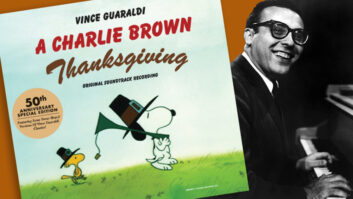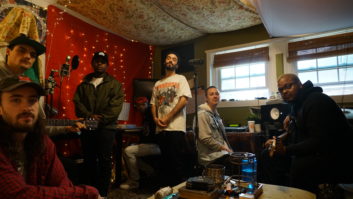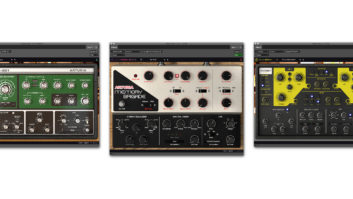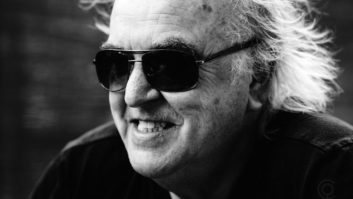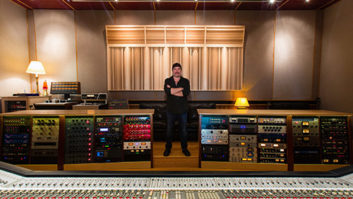An 1881 Steinway D Centennial concert grand piano is
the centerpiece at L. Brown Recording. There are few experiences more pleasing than to sit at an ornately carved 1881 Steinway D Centennial concert grand piano as its unimaginably honeyed tones fill the room. Add a brilliant, sunlit view of the Hudson River, and you just may transcend to the astral plane.

“The piano is extremely special,” agrees Louis Brown, principal of L. Brown Recording, located in New York’s historic Film Center Building. “They only made around 400 of these, between 1876 and 1884, for the Centennial of the United States. Doing classical music, I have to have something unique, and a Steinway D was a must.”
Founded in 2005, L. Brown Recording serves instrumentalists, singers and chamber groups in classical, jazz and acoustic music. As such, it is unlike many contemporary commercial studios, instead emphasizing elements particular to its clientele. “It needed to be a chamber music room,” says Brown. “It couldn’t be a soft room, and it couldn’t just look pretty: It really had to sound right and feel comfortable.”
The Steinway was rebuilt and is maintained weekly by Marc Wienert of Action Direct Piano. “To capture classical music,” says Brown, “it’s very important that it’s tuned and voiced to perfection, and Marc cares for this piano meticulously.”
A graduate of the Manhattan School of Music who also served as its chief recording engineer, making more than 10,000 recordings, Brown launched his studio on the site of a preexisting business. After a few successful years, he explains, a renovation was in order. He hired acoustician Alan Fierstein, of New York-based Acoustilog, along with architect Warren Ashworth and designer Madeline Nero, to help create the space he envisioned.
“Alan had the best reputation for soundproofing in the city, and I needed a quiet space,” Brown explains. “I’m on Ninth Avenue, in Midtown—great location, but noisy. I completely demolished the old space and reframed it. I was able to drop the ceiling three-and-a-half feet in the control room, quadruple- sheetrocked it, and triple-sheetrocked it in the live room—all of it resting on double-sheetrock isolated walls. I even had the plumbing taken out and hung underneath the new ceiling, and surface-mounted the electric to minimize punching holes through the new construction. I also left the windows, so I can get natural light and look over the Hudson River. It’s important to bring good performances out of people.”
Much like the action of playing a note on the Steinway—a hammer strikes a string and the resulting vibration emanates—every component of the studio seems to expand outward from this prominent element. An appreciation of its sounds leads to a discussion of the microphones with which Brown captures them; their all-important placement; and from there, the signal path through which they pass.
The capture of acoustic instruments, and particularly jazz and classical music, often relies on a small selection of specific microphones. This is largely the case at L. Brown Recording, as Brown points to pairs of mics such as Schoeps CMC 6/MK 2, Sennheiser MKH 20, Coles 4038, DPA 4006 and 4061, and Neumann KM 131. Also noteworthy is the considerable complement of Studio Projects microphones: L. Brown Recording boasts four C4 condensers with omni/cardioid and hypercardioid capsules; a pair of LSD-2 large-diaphragm stereo condensers; CS5 multi-pattern condensers; and a T3 multi-pattern tube microphone.
“I do some research and development with PMI Audio in California,” Brown points out. “I have worked closely with Brent Casey, their main designer/engineer. With Brent, I helped create the redesign of their C4 microphone—I found that these things really had potential. The redesigned C4 microphone has similar characteristics to the Schoeps and the Neumanns. These [Studio Projects] microphones are quiet, offer high SPL handling and have a frequency response similar to those other microphones. I consistently use them on the piano and on singers. But I had a hand in making them what they are, so they are specific, and the clients love them. I put them alongside the expensive guys, and they always hold up. Sometimes, I dare say, they’re really the right thing for the right situation, though they’re all unbelievable.”
The control room features a Toft Audio Designs ATB24 with meter bridge. “I like the analog stage of British sound,” says Brown. “I love the Toft design—it is the old Trident board design, Malcolm Toft being the original co-designer, with John Oram. This board really gives you that classic sound. It was the proper fit for my place. My flow is from microphone to preamp to A/D to computer; out of the computer, I’m running into the board. That said, I think that stage of the board brings an exceptional, familiar sound to recordings that people really love, especially people in the classical and jazz industry.”
The signal path at L. Brown Recording is simple and direct. “John Hardy customized a couple of the channels for me,” Brown says of the eight channels of M1 preamplifiers. “I also use Millennia HV3D mic pres. Everything is really all about miking. I don’t use any fancy signal processing—I don’t have a need for it, especially in my studio where I’m able to control everything. I use Lexicon M300 and 480L reverb, that’s the only outboard gear I really use.” Brown also favors Lynx Aurora 16 (PCM) and Genex GXA8/ GXD8 (DSD) converters.
From growing up as a guitarist with rock ’n’ roll music and a studio in the attic, Brown’s passion has become an avocation. Recently, he became the audio consultant for the Lindemann Young Artist Development Program at the Metropolitan Opera, which provides specialized training in music, language, dramatic coaching and movement from the Met’s own staff and invited master teachers.
“The people I went to school with, and the musicians I work with—at the Metropolitan Opera, New York Philharmonic, or anywhere— need recordings, a place to go, a real piano, and somebody who understands how to capture a performance. I’ve worked with a lot of great artists because of it.”
L. Brown Recording
lbrownrecording.com
